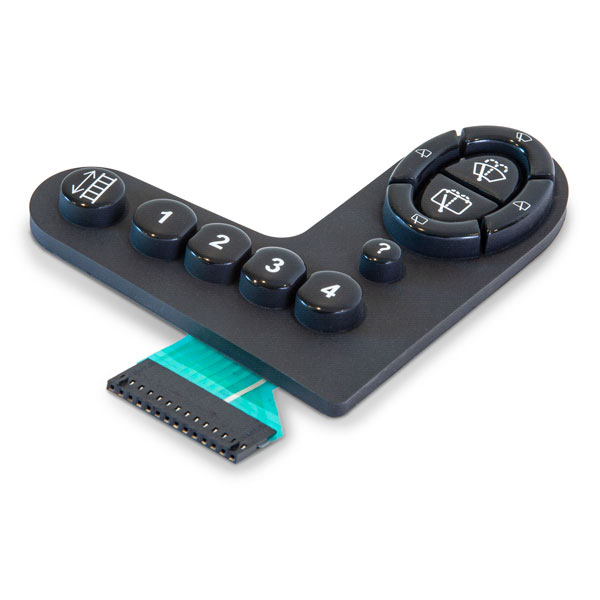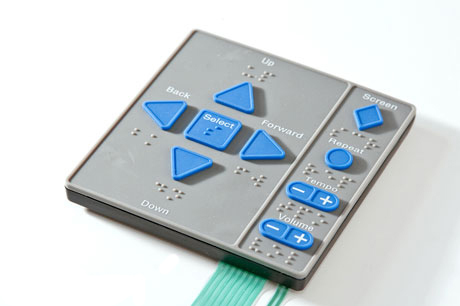How Membrane Switch Technology is Revolutionizing User Interfaces
How Membrane Switch Technology is Revolutionizing User Interfaces
Blog Article
Understanding Membrane Layer Changes: The Key to Trusted and long lasting Controls

What Are Membrane Layer Switches?
Membrane buttons are an innovative remedy in the world of interface innovation, incorporating functionality and design effortlessly. These tools act as an interface between users and digital systems, integrating numerous parts right into a portable style. Commonly constructed from versatile, thin layers of products, membrane buttons are made to reply to touch, enabling individuals to communicate with equipment and digital tools efficiently.
The primary components of a membrane layer switch include a printed circuit layer, graphic overlay, and a spacer layer that avoids unintentional activation. The graphic overlay can be personalized to reflect brand identification or user preferences, boosting aesthetics while making certain usability. Membrane layer buttons are typically utilized in numerous applications, consisting of clinical gadgets, consumer electronic devices, and commercial devices, owing to their durability and resistance to environmental variables such as wetness and dirt.
Among the essential advantages of membrane layer switches is their capability to endure wear and tear, making them perfect for high-traffic atmospheres. Furthermore, they are light-weight and need marginal room, permitting innovative layouts in product advancement. On the whole, membrane layer changes stand for a efficient and functional choice for modern electronic user interfaces, marrying innovation with user-centric style principles.
Exactly How Membrane Layer Switches Over Job
The operation of membrane changes joints on a simple yet efficient system that converts customer input right into electronic signals. When a customer presses the button, the leading layer warps, allowing a conductive component in the circuit layer to make contact with an equivalent conductive pad on the underside of the graphic overlay.
The style of membrane switches can vary, but they typically integrate domes or tactile elements to supply feedback to the customer, improving the overall experience - membrane switch. The materials used in membrane switches, such as polyester or polycarbonate, add to their resilience and resistance to environmental aspects, including moisture and dirt. The published circuits are usually enveloped, which secures them from wear and tear over time.
Advantages of Membrane Buttons

Additionally, membrane switches are understood for their longevity. Built from robust products, they are resistant to dust, dampness, and physical wear, which dramatically prolongs their lifespan compared to standard mechanical switches. This toughness makes them particularly suitable for high-traffic atmospheres and applications requiring long life.
One more considerable benefit is the simplicity of cleansing and maintenance. The smooth surface of membrane changes reduces dirt buildup and is frequently resistant to spills, making them optimal for settings that call for frequent sanitization.
Furthermore, membrane switches use a streamlined account, resulting in a thinner layout that can be incorporated into different gadgets without adding mass. This attribute not just improves the visual charm however also adds to a more ergonomic product layout.
Applications of Membrane Buttons
User-friendly and versatile, membrane switches discover applications throughout a wide variety of sectors, including medical devices, consumer electronics, and industrial devices. In the clinical area, these buttons are integral to devices such as analysis equipment, individual tracking systems, and mixture pumps, where reliability and convenience of cleaning are critical. Their ability to withstand severe settings and preserve performance makes them excellent for such applications.

In customer electronic devices, membrane buttons are made use of in products like microwaves, washing equipments, and remotes - membrane switch. Their smooth design permits intuitive customer interfaces, improving the total individual experience while giving sturdiness and resistance to tear and wear
Industrial devices likewise takes advantage of membrane switches, specifically in control panels for machinery and automation systems. These switches use defense against dirt and dampness, guaranteeing regular efficiency in difficult atmospheres. Furthermore, their customizable functions enable suppliers to tailor them to details operational requirements, boosting performance and performance.
Picking the Right Membrane Switch Over
When selecting a membrane layer button, it is vital to think about numerous elements that influence performance and viability for details applications. The primary factors to consider consist of environmental conditions, responsive feedback, toughness, and style specs.
First, evaluate the operating environment; buttons exposed to dampness, chemicals, or Get the facts extreme temperatures need certain products to guarantee long life and performance. Next off, assess the requirement for tactile responses. Depending upon individual interaction, some applications might take advantage of a tactile response to validate activation, while others may prefer a non-tactile layout for aesthetic reasons.
Durability is an additional important aspect; membrane layer buttons must be developed to withstand constant usage, influences, and abrasion. Make sure the selected button can endure the anticipated lifecycle, particularly in high-usage circumstances.

Conclusion
In conclusion, membrane changes offer as vital parts in the design of reputable and sturdy control systems across different sectors. The versatility of membrane changes permits for customized solutions that meet details operational requirements, strengthening their value in modern technology.
Membrane switches stand for an important facet of modern-day interface design, blending functionality with resilience in various applications.Membrane layer switches are a sophisticated service in the realm of user interface innovation, integrating performance and style flawlessly. Typically constructed from flexible, slim layers of products, membrane layer buttons are created to react official source to touch, making it possible for individuals to interact with machinery and electronic gadgets properly.
The layout of membrane layer switches can vary, article but they often incorporate domes or responsive components to supply comments to the individual, boosting the total experience.In final thought, membrane switches offer as crucial parts in the style of resilient and reputable control systems across numerous markets.
Report this page